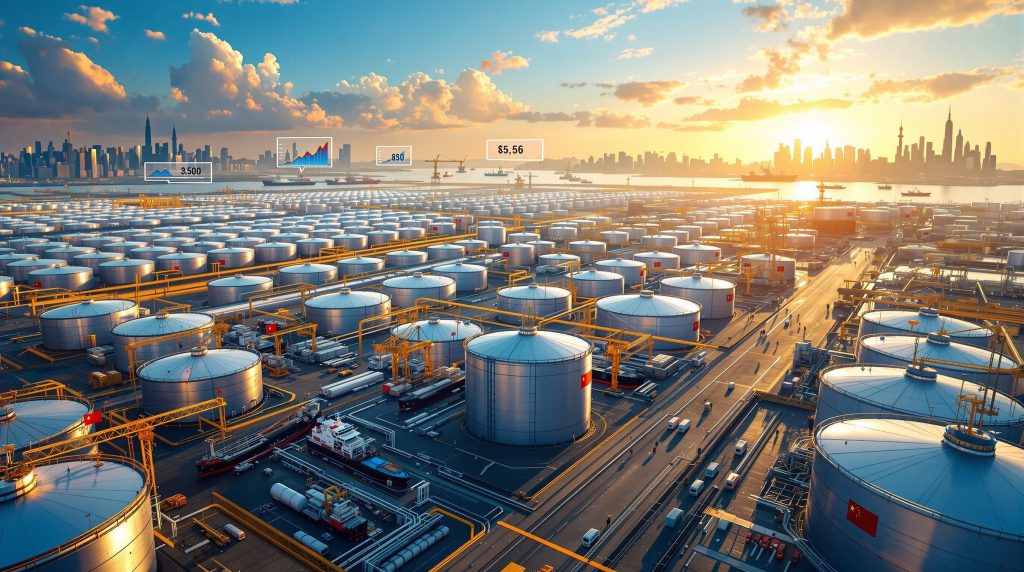China's Oil Buying Spree Won't Stop Coming Glut
China's oil buying spree won't stop coming glut as market analysts predict an oversupply despite the Asian giant's aggressive purchasing behaviour. The world's largest crude importer has been on a relentless acquisition campaign throughout 2025, taking advantage of relatively attractive pricing opportunities. However, this purchasing frenzy is proving insufficient to prevent what many industry experts now forecast as an inevitable global oil surplus heading into 2026.
The disconnect between China's appetite for crude and the broader market fundamentals highlights the complex dynamics at play in global energy markets. While Chinese refiners continue filling storage facilities at unprecedented rates, multiple factors are converging to create downward pressure on prices despite this apparent demand strength.
Market Fundamentals Point to Oversupply
The International Energy Agency (IEA) recently released projections indicating global oil markets face a potential record supply glut next year. This comes despite China's strategic petroleum reserve expansion continuing at a rapid pace. According to the IEA's latest monthly report, global oil supply is expected to exceed demand by approximately 1.5 million barrels per day by mid-2026.
This imbalance stems from several concurrent developments:
- Persistent production increases from non-OPEC sources
- Recovering output from previously disrupted regions
- Slower-than-expected global economic growth
- Accelerating energy transition affecting long-term demand forecasts
These factors have contributed to significant oil price stagnation in recent months, despite temporary rallies driven by geopolitical tensions and strategic buying.
"The market is clearly transitioning from a state of relative tightness to one of potential oversupply," notes energy analyst Sarah Chen. "While China's stockpiling provides temporary support, it cannot indefinitely mask the growing supply-demand imbalance."
China's Strategic Reserves Expansion
China's crude stockpiling strategy represents a multifaceted approach to energy security and economic leverage. The country has been aggressively filling both commercial and strategic petroleum reserves whenever favourable pricing windows emerge. According to data from energy research firm Kpler, Chinese crude imports averaged 11.8 million barrels per day in the first eight months of 2025, an increase of 6.5% compared to the same period last year.
This sustained buying has been particularly notable given the broader recent oil price rally that temporarily pushed Brent crude above $90 per barrel earlier this year. However, according to Bloomberg, oil traders are increasingly focused on China's purchasing behaviour as a key indicator of market direction.
"China is essentially front-loading its purchases while simultaneously expanding storage capacity," explains commodities strategist Michael Wu. "However, this pattern isn't sustainable indefinitely and masks underlying weaknesses in actual consumption growth."
Refining Overcapacity Creates Product Glut
Beyond crude stockpiling, China's massive refining sector expansion has created additional market complications. After building substantial gasoline surpluses that pressured regional markets, Chinese refiners now face a growing jet fuel glut amid slower-than-expected recovery in international aviation.
This product oversupply situation is further complicating market dynamics as:
- Export quotas have been expanded to relieve domestic pressure
- Regional refining margins face compression from Chinese exports
- Global product markets struggle to absorb excess supply
Furthermore, the OPEC production impact remains uncertain as the producer group weighs competing priorities of market share versus price support. Several analysts predict that OPEC+ may need to extend and potentially deepen production cuts to prevent a precipitous price decline once China's buying inevitably moderates.
Financial Markets Signal Concern
Sophisticated market indicators are increasingly signalling concern despite the apparent strength in physical oil demand from China. The futures curve structure, once showing backwardation (a bullish signal where prompt prices exceed future deliveries), has flattened considerably in recent weeks.
Additionally, options markets reveal growing interest in downside protection, with put skews becoming more pronounced. These financial signals suggest growing oil price crash analysis among professional traders who anticipate potential market weakness once China's inventory build slows.
Investment bank Goldman Sachs recently revised its oil price forecast downward, citing "China's unsustainable purchasing pattern" among key factors. Their analysts now project Brent crude averaging $75 per barrel in the first half of 2026, down from previous estimates of $85.
Geopolitical Factors Add Complexity
The ongoing trade war oil movements continue introducing volatility into markets already grappling with fundamental imbalances. Tariff policies and strategic competition between major economies add layers of uncertainty to both supply and demand projections.
China's buying behaviour itself may partially reflect geopolitical calculus rather than purely economic rationale. By aggressively expanding strategic reserves during periods of relative price weakness, Beijing gains both energy security and potential leverage in future negotiations.
China's crude stockpiling is set to continue through 2026, according to industry analysts, but at a gradually decreasing rate as storage capacity constraints and economic considerations come into play. This eventual slowdown in Chinese purchases could accelerate the timeline for global oversupply.
Market Outlook Remains Bearish
Despite temporary price rebounds driven by short-covering and opportunistic trading, the medium-term outlook for oil markets remains decidedly bearish. Once China's extraordinary buying campaign moderates, underlying fundamentals will likely reassert themselves more forcefully.
Key factors that will determine the severity of the coming glut include:
- The pace and magnitude of China's continued stockpiling
- OPEC+ cohesion and production discipline
- Global economic growth trajectory
- The speed of energy transition in key markets
"We're essentially witnessing a temporary postponement of the inevitable," states energy economist Dr. Mei Zhang. "China's buying spree won't stop coming glut, it merely delays and potentially deepens the eventual correction."
For market participants, navigating this transition period requires careful analysis of both Chinese purchasing patterns and broader supply-demand indicators. The apparent strength in physical markets today may provide a false sense of security if mistaken for sustainable demand growth rather than strategic stockpiling.
Looking to Navigate the Coming Oil Market Changes?
Stay ahead of market shifts by understanding how China's buying behaviour affects global oil dynamics. Visit Discovery Alert's dedicated discoveries page for actionable insights powered by the proprietary Discovery IQ model, helping investors identify opportunities before the broader market.




